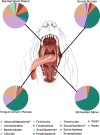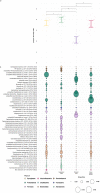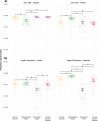The canine oral microbiome: variation in bacterial populations across different niches
- PMID: 32111160
- PMCID: PMC7048056
- DOI: 10.1186/s12866-020-1704-3
The canine oral microbiome: variation in bacterial populations across different niches
Abstract
Background: Microbiota from different niches within the canine oral cavity were profiled and compared. Supragingival plaque and stimulated saliva, were collected alongside samples from the buccal and tongue dorsum mucosa, from 14 Labrador retrievers at three timepoints within a 1 month timeframe. The V3-V4 region of the 16S rRNA gene was sequenced via Illumina MiSeq.
Results: Supragingival plaque microbiota had the highest bacterial diversity and the largest number of significant differences in individual taxa when compared to the other oral niches. Stimulated saliva exhibited the highest variability in microbial composition between dogs, yet the lowest bacterial diversity amongst all the niches. Overall, the bacteria of the buccal and tongue dorsum mucosa were most similar.
Conclusions: The bacterial community profiles indicated three discrete oral niches: soft tissue surfaces (buccal and tongue dorsum mucosa), hard tissue surface (supragingival plaque) and saliva. The ability to distinguish the niches by their microbiota signature offers the potential for microbial biomarkers to be identified in each unique niche for diagnostic use.
Keywords: Buccal; Canine; Microbiome; Oral; Plaque; Saliva; Tongue.
Conflict of interest statement
All authors were employees of WALTHAM Petcare Science Institute (Mars Petcare) at the time of the study and declare that they have no competing interests.
Figures




Similar articles
-
Exploring the oral microflora of preschool children.J Microbiol. 2017 Jul;55(7):531-537. doi: 10.1007/s12275-017-6474-8. Epub 2017 Apr 22. J Microbiol. 2017. PMID: 28434085
-
Impact of sleep on the microbiome of oral biofilms.PLoS One. 2021 Dec 9;16(12):e0259850. doi: 10.1371/journal.pone.0259850. eCollection 2021. PLoS One. 2021. PMID: 34882696 Free PMC article.
-
The Oral Microbiome in the Elderly With Dental Caries and Health.Front Cell Infect Microbiol. 2019 Jan 4;8:442. doi: 10.3389/fcimb.2018.00442. eCollection 2018. Front Cell Infect Microbiol. 2019. PMID: 30662876 Free PMC article.
-
Profiling of Oral Bacterial Communities.J Dent Res. 2020 Jun;99(6):621-629. doi: 10.1177/0022034520914594. Epub 2020 Apr 14. J Dent Res. 2020. PMID: 32286907 Free PMC article. Review.
-
Hormonal Environment Shapes the Oral Microbiome.Adv Exp Med Biol. 2025;1472:225-242. doi: 10.1007/978-3-031-79146-8_14. Adv Exp Med Biol. 2025. PMID: 40111695 Review.
Cited by
-
Analysis of Tick Surface Decontamination Methods.Microorganisms. 2020 Jun 30;8(7):987. doi: 10.3390/microorganisms8070987. Microorganisms. 2020. PMID: 32630152 Free PMC article.
-
Assessment of Changes in the Oral Microbiome That Occur in Dogs with Periodontal Disease.Vet Sci. 2021 Nov 27;8(12):291. doi: 10.3390/vetsci8120291. Vet Sci. 2021. PMID: 34941818 Free PMC article.
-
Insights into the Oral Bacterial Microbiota of Sows.Microorganisms. 2021 Nov 9;9(11):2314. doi: 10.3390/microorganisms9112314. Microorganisms. 2021. PMID: 34835441 Free PMC article.
-
Investigation of Oral Microbiome in Donkeys and the Effect of Dental Care on Oral Microbial Composition.Animals (Basel). 2020 Nov 30;10(12):2245. doi: 10.3390/ani10122245. Animals (Basel). 2020. PMID: 33266023 Free PMC article.
-
Correlating the oral swab microbial community with milk production metrics in Holstein dairy cows.mSphere. 2025 Jun 25;10(6):e0016725. doi: 10.1128/msphere.00167-25. Epub 2025 May 14. mSphere. 2025. PMID: 40366128 Free PMC article.
References
Publication types
MeSH terms
Substances
LinkOut - more resources
Full Text Sources
Other Literature Sources
Medical

